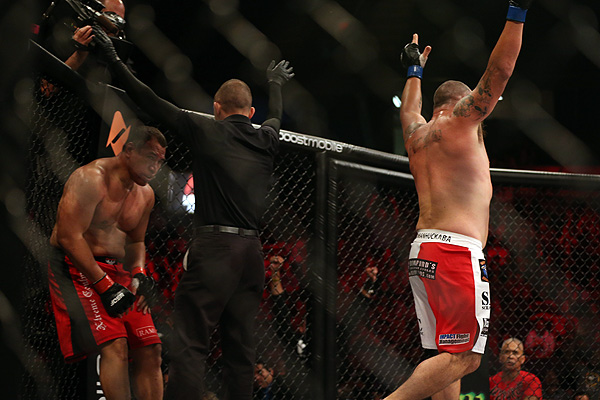Fight Medicine: Fighting After 40

Ray
Sefo, who turned 42 in February, came up short at World Series of
Fighting 4. | Photo: Dave Mandel/Sherdog.com
World Series of Fighting 4 on Saturday at the Citizens Bank Arena in Ontario, Calif., saw two veterans over the age of 40 step into the cage: World Series of Fighting President Ray Sefo, 42, and former Maximum Fighting Championship lightweight titleholder Antonio McKee, 43. Both lost.
The question of when age plays a role in a fighter’s career is becoming an increasingly important point. George Foreman won boxing’s heavyweight championship at age 45, and Randy Couture won the Ultimate Fighting Championship heavyweight crown at age 43. Both men are examples of courage, drive and exceptional talent, but when does Father Time win by TKO?
Advertisement
In addition to changes in muscle mass, changes in how joints feel and act also occur. Arthritis is the wearing away of cartilage, which does not have the ability to repair itself. If the arthritis becomes bad enough, surgery can be performed to exchange bones for metal and plastic, but once that happens, it is definitely time to retire; ask Mark Coleman after his hip replacement surgery. Damage to ligaments such as the ACL is often accompanied by other injuries, like meniscus tears and direct cartilage injuries. Even if surgery is performed to repair torn ligaments and tendons, the acceleration of cartilage degradation has begun, and there is no cure or reversal for arthritis. As a result, aging athletes often develop painful and stiff joints.
Now we have an aging athlete that is slower, less powerful, stiff and pained. It is not exactly the recipe for success. Unfortunately, this can spell disaster for a mixed martial arts competitor, especially one that relies more on strength than technique. Standup fighters like Sefo rely on their striking ability to win fights. Once they slow down, they deliver less damage to their opponent and often take more damage than they might have otherwise absorbed.
Repeated blows to the head, like those Sefo experienced at the end of the second round of his loss to Dave Huckaba, can cause repetitive brain injury. Repeated traumatic brain injury can lead to a chronic condition known as chronic traumatic encephalopathy, which is basically a long-term swelling of the brain. CTE has come into the spotlight recently with the increased awareness of concussions in the NFL and suicides of notable former players such as Junior Seau.
It has always been suspected that boxers who take a lot of punches are never the same, but no one really understood why. Even now, we have autopsy results that show the signs of CTE, but the specific mechanism of how it unfolds and how it can be measured remain mysteries and areas of active research. In mixed martial arts, we have not seen the effect of long-term traumatic brain injury for two main reasons. First, the sport lends itself to shorter fights than boxing, as fighters can become injured or lose in ways other than being punched repeatedly in the head; and second, the sport is still relatively young, with the older generation still in its 40s and 50s. As time goes on, we may start to see more and more fighters becoming affected by CTE.
Sefo has shown he has amazing heart, which is one trait that can grow with age. However, when he stepped into the cage at WSOF 4, he had two opponents: Huckaba and Father Time. Both won by TKO with repeated blows to the head.
Want your question answered by The Fight Doctor in the FightMedicine Mailbag? You can contact him by email at fightmedicine@sherdog.com or find him on Twitter @fightmedicine. You can also read more about MMA Injuries, Health, and Training at FightMedicine.net.







